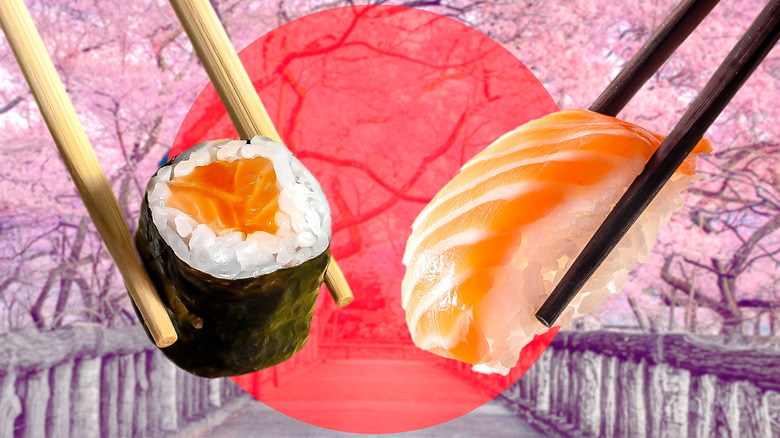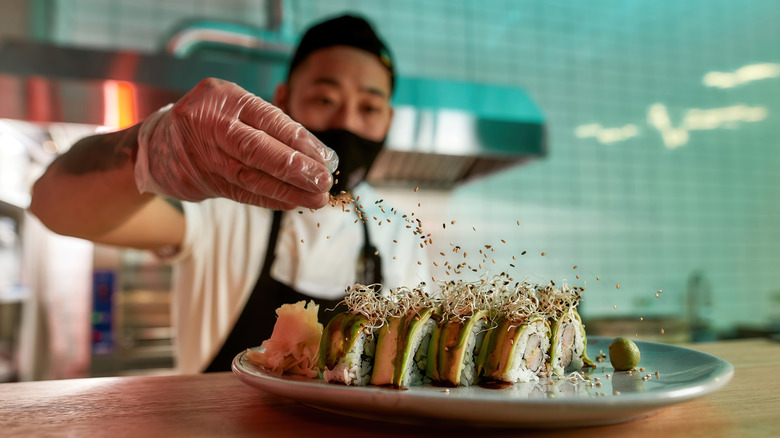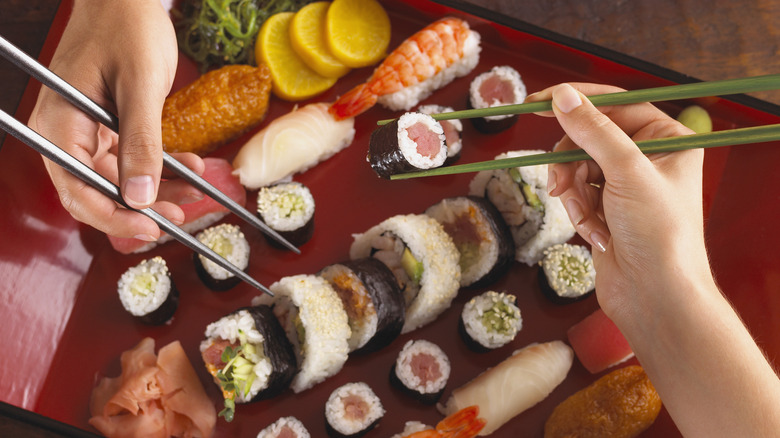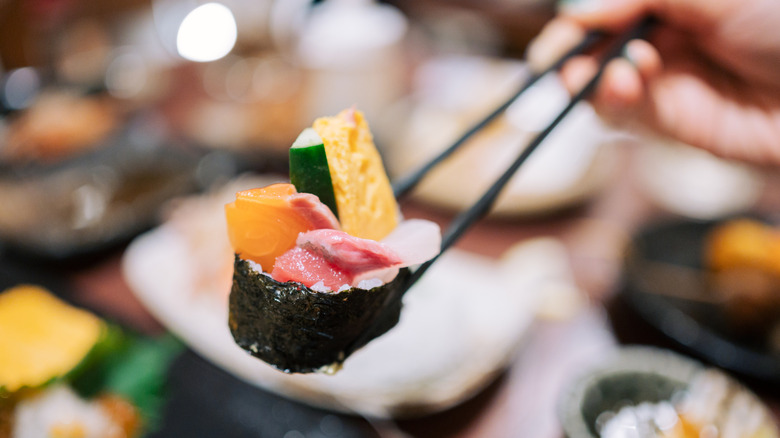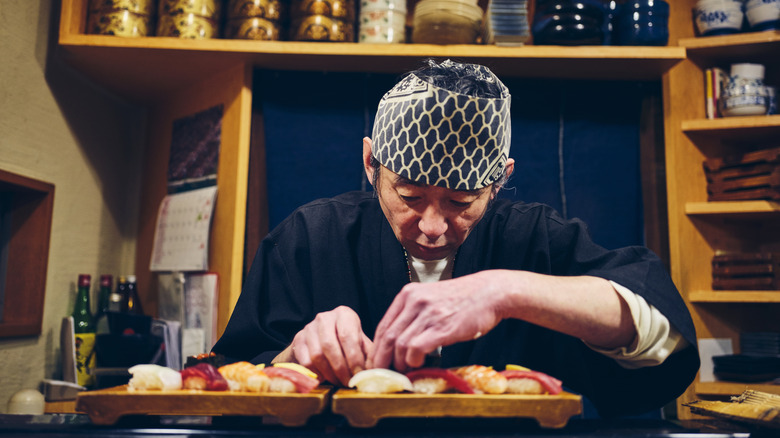What's The Difference Between Maki Sushi And Nigiri?
More than with most types of cuisine, sushi has a considerable amount of terminology that you need to understand if you want to be sure of what you're ordering, but it's worth the trouble familiarizing yourself with the delicious seafood lingo. You may be surprised at how much you already know about the topic but didn't yet have the words for. While we have plenty of tips for making homemade sushi, we'll be focusing instead on how most of us relate to sushi: restaurants.
At this point, most of us are familiar with sushi as a category of food. The raw fish morsels sit just as comfortably at your friendly neighborhood grocery store as they do all the way up to Michelin-starred sushi restaurants like Hōseki and everywhere in between. Maki sushi and nigiri are the two main subcategories in the sushi family. Sashimi is often lumped in with them but, because it doesn't have rice, it's not actually a type of sushi. From handrolls to fat rolls and from albacore to sea urchin, there's something for everyone.
What is maki sushi?
You're probably more accustomed to seeing maki sushi labeled as rolls, though that's only a small part of the maki sushi genre. Maki sushi is also sometimes referred to as makizushi or norimaki. This type can be broken down into four subcategories: hosomaki, uramaki, futomaki, and temaki.
Hosomaki are known as thin rolls because they're quite small. If you order a spicy tuna roll, and it comes out with tiny pieces that pop into your mouth, that's hosomaki. Usually, it's just the fish, rice, and seaweed with maybe a sauce or a piece of cucumber inside. Uramaki are inside-out rolls and are so-called because the rice is on the outside of the roll, followed by seaweed, with the fish and other ingredients in the middle. Futomaki are called fat rolls because they're filled with lots of ingredients. They're very similar to uramaki; only the rice and seaweed have swapped places.
And finally, temaki are hand rolls. Not every sushi restaurant has hand rolls listed on the menu, but you should be able to ask for one if you want. They look like a seafood ice cream cone with all the ingredients typical of other maki sushi arranged in holdable form. There's no limit to what's possible with sushi, which seems unlikely given how few ingredients are involved. Maki sushi is a restaurant staple, and you will often see it highlighted on the menu as the main course.
What is nigiri?
Nigiri is very straightforward, but its simplicity belies hidden depths. At its most basic, nigiri is a ball of rice with a slice of raw fish draped on top. Traditionally, sushi chefs will place a dab of wasabi between the rice and the fish, though the practice isn't universally adhered to in the West, where wasabi isn't always popular.
When you order nigiri it will often come as a plate of two pieces. All you do is pick which fish you want to eat and that's it, no messy complications. You might order, say, a plate of hamachi nigiri or unagi nigiri (which is eel) and that's it: You specify the fish and the style. If you want rice with the fish, make sure you order nigiri instead of sashimi — they are often placed together on the menu since, in both cases, you are picking the fish you want to eat, but if you just name the fish, the chef won't know what style you're looking for.
It's worth noting that nigiri plays different roles in each restaurant. For everyday sushi restaurants, nigiri is sometimes relegated to the sidelines, while the rolls take center stage — not so with top-tier sushi restaurants. It's much less common for the very best sushi restaurants in the world (where you shouldn't ask for extra soy sauce) to be highlighting anything other than nigiri. While maki sushi provides a good foundation, nigiri is the blazing fire at the mountain's peak.
Sweet, sweet seaweed
As you may have already noticed, one primary difference between maki sushi and nigiri is the presence of seaweed. Seaweed is also referred to as nori (hence the alias for maki sushi: norimaki). Seaweed is used to provide structure to maki sushi, which would otherwise fall apart and dissolve into a bite-sized sushi bowl. It doesn't hurt that it adds notes of salty umami to whatever it touches.
There are a few exceptions, but with nigiri, the seaweed is usually stripped away, allowing the fish itself to shine. The rice adds some nice body to it, but the fish meat takes center stage — so much so that purists say that the proper way to eat nigiri is to turn it upside down when you eat it so that the fish is what first hits your tongue instead of the rice. If you're dipping your nigiri in soy sauce, this also keeps pieces of rice from falling off and floating around in your soy sauce dish. However you choose to eat it, the dynamic duo of rice and fish are free to flaunt their prowess with the minimalist simplicity of a piece of nigiri.
Minimalism versus maximalism
While this aspect isn't as objective as it could be, there's a real difference in the ethos behind the two styles of sushi that helps shed light on their personalities. Sushi in general is a deceptively simple style of food, but nigiri takes that idea and runs with it. Maki sushi can be minimalist, as with hosomaki, but when we think of maki sushi in the West we typically think of big rolls with lots of ingredients and complex flavors.
Each style can be unbelievably delicious, so it's not as if one is better than the other, but sushi does sit on something of a spectrum that spans this range. The most maximalist maki sushi might have deep-fried shrimp, three different vegetables, and a sliver of fish on the inside while being covered in fish eggs and a second layer of fish meat on top. A sushi chef can get very creative in how flavors and textures play off of each other when making maki sushi.
Nigiri doesn't have as many variables. There's a ball of rice, a piece of fish meat, and maybe a dab of wasabi in between. It's minimalist food at its finest. In this light, it seems incredible that premium sushi restaurants would focus so much on their nigiri offerings. With so little to work with, how do they expect to distinguish themselves from other restaurants? The secret lies in the technique.
To bamboo or not to bamboo
The final difference we're going to talk about deals with how the sushi is made. Becoming a master sushi chef requires an immense amount of knowledge and finely tuned technique. However, you don't need to dedicate years of your life to understand the basic differences in how both maki sushi and nigiri are made.
If there's one thing that differentiates the two preparation styles, it's the bamboo rolling mat. For maki sushi, the sushi chef uses the bamboo mat as a way to evenly spread pressure across the roll so that the ingredients don't bunch up in one specific spot. Nigiri is made by hand without a bamboo mat. A good piece of nigiri has a lot to do with the quality of the fish, but the rice ball is also important. If the rice is packed too tightly, it becomes a dense brick that you have to chew through. A good rice ball is loose enough to fall apart in your mouth but not so loose that it falls apart on the plate.
While technique matters for both styles, you can more easily hide a subpar technique behind an array of good ingredients with maki sushi. Imperfect nigiri is much harder to disguise. Perhaps that's why top-tier sushi chefs tend to showcase their talents with nigiri.
